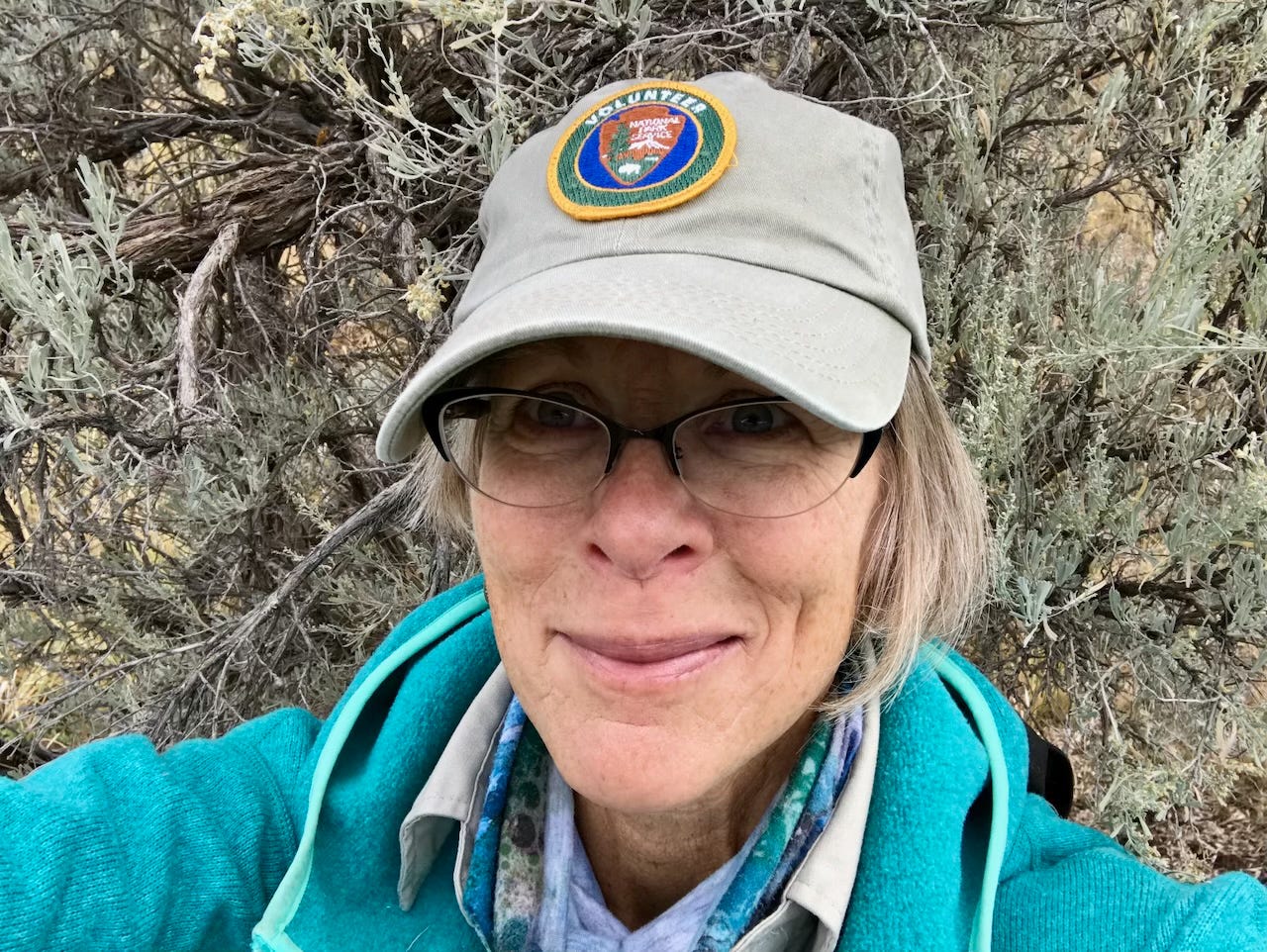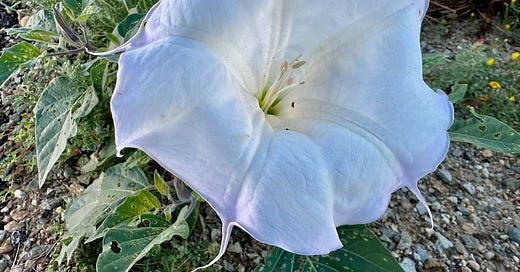ethereal— sacred datura wafts sweet scent beguiling, dangerous
These blossoms open in the cool of evening and broadcast a sweet, lemony scent into the night air, calling in hovering moths to pollinate them. The entire plant, flowers and all, is filled with powerful halllucinognic compounds that can give you incredible visions—or, just as likely, blind you or kill you. Yet somehow their pollinators survive sipping the poisoned nectar. A gorgeous enigma.
Good morning, friends! We’re headed into a hot day here in the high desert and the world seems bent on chaos and tragedy. The sacred datura flowers I admired this morning on my walk feel like a metaphor for these times: beauty and danger inextricably intertwined, not separable, part of each other at the deepest level.
In the midst of all that, I am grateful for my life, grateful to be able to walk at sunrise and watch a roadrunner skulk under the juniper trees, hunting; hear a hummingbird zip past on hovering wings; and admire the ethereal ivory trumpets of sacred datura flowers, deadly as they may be.
And I am especially grateful to you, readers and subscribers, because you give me motivation to continue my mission of practicing terraphilia, living with love for the more-than-human world around us. I think of this newsletter as my ministry of inspiration and active hope. Thank you!
I know a lot of you are new to Practicing Terraphilia, so I want to re-introduce myself and also the idea of terraphilia.

Who I am
I’m a certified plant-nerd who grew up in a family culture of science and nature study; my parents and only sibling were and are avid birdwatchers. I turned to plants because they don’t get up early and they hold still when you want to identify them. I’m trained in community ecology, the study of the interrelationships between plants and all other beings who weave this green and animate planet.
I began my career studying grizzly bear habitat—and yes, for a botanist that involves collecting and dissecting piles of bear poop—wildfire behavior, and researching big sagebrush. After nearly a decade of fieldwork, I turned to writing, compelled by the stories behind the data.
I’ve written thirteen books on the nature of life and our place in it, along with hundreds of magazine articles, newspaper columns, and essays. My latest book, Bless the Birds: Living With Love in a Time of Dying, won the Sarton Award for memoir. I’ve taught writing workshops around the country, coached writers, served as a juror for fellowships and awards, and reviewed manuscripts for publishers and agents.
When I’m not writing, I’m “re-storying” the world around me, bringing unloved houses and damaged pieces of land back to life. I’ve restored, finished or helped build ten homes in the past decade-plus, learning from amazing friends and tradespeople as I did, and revived industrial sites, city parks, wild lands, and an urban creek.
I’m a widow who has learned to cherish her life as femme solo, a step-mom, a sister and friend; a Quaker, gardener, a lover of life and lives.
All of my work—writing and re-storying and tending land and home—is driven by terraphilia, and my mission to heal my patch of this numinous earth, and we who share the planet.
What’s Terraphilia?
terraphilia n. An intrinsic affection for and connection to the earth and its community of lives. Without this bond we are lonely, lacking, no longer whole. Origin: terra, Latin, literally ‘earth’; philia, from the Greek, ‘fondness.’
Terraphilia, a word that my late husband and I borrowed and defined to explain what motivated our work, is our birthright as humans who evolved on a living planet, part of the interconnected and interdependent web of lives who give Earth its green and vibrant skin.
It is the bond that gives us community, an existence that stretches wider and deeper than merely the human world. No matter how deep we bury that link to the more-than-human world, it is there, bred into our very cells, an essential part of what makes us human.
I believe that practicing and exercising that bond may be what saves us, individually and collectively.
It’s not hard.
As I wrote in my book-in-progress, Ditch & Meadow: How Re-Storying Our Yards and Neighborhoods Could Save the Earth and Ourselves,
Practicing terraphilia is not a prescription or a recipe; it is an individual way of attentive and respectful daily living that issues from the leadings of head, heart and spirit.
The idea of practicing terraphilia may seem too quotidian or inconsequential to be effective against the pervasive ills of today, but over time, living with love for each other and the planet has great power to reclaim humanity and to re-story Earth and our future.
Practicing terraphilia means opening our hearts and daring to love—our own selves, the other lives around us, and this numinous planet. Expressing our humanity every day of our lives.
By the way, I never share work in progress. But I am so passionate about this book and the idea of “re-storying” our nearby spaces, the words just clamor to be out in the world!
An Ask
If you find this newsletter useful, please share it widely. And please consider supporting my work financially by becoming a paid subscriber. Ninety-nine of you are supporting me as paid subscribers—thank you, thank you, thank you! I am deeply grateful for your belief in my work. I’d love to find that hundredth paid subscriber soon, and by the end of the year, make it to 200. It’s a big goal, but you can help me get there.
I’m glad you’re here with me on this journey of practicing our terraphilia.
Thank you! Blessings, Susan






Just upgraded to paid; I hope I'm your #100! Thank you for what you do, what you write, how you live, and how you share it with all of us.
Wonderful and so lovely, Susan! It's nice to meet a kindred spirit who re-storys buildings and nature!Cheers and hugs!